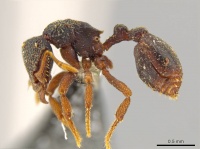Octostruma leptoceps
| Octostruma leptoceps | |
|---|---|

| |
| Scientific classification | |
| Kingdom: | Animalia |
| Phylum: | Arthropoda |
| Class: | Insecta |
| Order: | Hymenoptera |
| Family: | Formicidae |
| Subfamily: | Myrmicinae |
| Tribe: | Attini |
| Genus: | Octostruma |
| Species: | O. leptoceps |
| Binomial name | |
| Octostruma leptoceps Longino, 2013 | |
This is known from a single worker collected in mesophyll cloud forest at 1290 m elevation. The specimen was in a sample of sifted leaf litter from the forest floor.
Identification
Basal five teeth of mandible acute; labrum triangular with straight, evenly converging sides, anterior lobes converging and confluent at apex, such that labrum apex is blunt but not distinctly bilobed; head very narrow, CI 94. (Longino 2013)
Keys including this Species
Distribution
Latitudinal Distribution Pattern
Latitudinal Range: 15.4894° to 15.4881761°.
| North Temperate |
North Subtropical |
Tropical | South Subtropical |
South Temperate |
- Source: AntMaps
Distribution based on Regional Taxon Lists
Neotropical Region: Honduras (type locality).
Distribution based on AntMaps
Distribution based on AntWeb specimens
Check data from AntWeb
Countries Occupied
| Number of countries occupied by this species based on AntWiki Regional Taxon Lists. In general, fewer countries occupied indicates a narrower range, while more countries indicates a more widespread species. |

|
Estimated Abundance
| Relative abundance based on number of AntMaps records per species (this species within the purple bar). Fewer records (to the left) indicates a less abundant/encountered species while more records (to the right) indicates more abundant/encountered species. |

|
Biology
|
Castes
Known only from the worker caste.
Nomenclature
The following information is derived from Barry Bolton's Online Catalogue of the Ants of the World.
- leptoceps. Octostruma leptoceps Longino, 2013: 38, figs. 1A, 5H, 28, 43 (w.) HONDURAS.
Unless otherwise noted the text for the remainder of this section is reported from the publication that includes the original description.
Description
Worker
HW 0.68, HL 0.73, WL 0.87, CI 94 (n=1); Labrum sides straight, strap-like lateral portions converging from base to apex, apex bluntly rounded, not bilobed; mandible triangular, in profile view with mandible closed, base in same plane as clypeus, evenly curved downward toward apex; mandibles closed on holotype, but basal teeth visible, acute, tooth 1 continuous with basal rim of dorsal surface; dorsal surface of mandible roughened; ventral surface flat, smooth and shining; interior surface concave, smooth and shining; scape with pronounced anterobasal lobe, dorsal surface smooth, matte; clypeus with broad, shallow emargination anteriorly; clypeus smooth, sublucid, with sparse puncta; face uniformly irregularly rugose; frontal carinae faint, nearly obsolete; antennal socket deep, dorsal rim of socket continuous with pronounced dorsal margin of antennal scrobe; antennal scrobe deep, strongly delimited dorsally, posteriorly, and ventrally with sharply defined thin cuticular rim; compound eye small, circular, composed of about 7 ommatidia; distinct carina extends from ventral margin of antennal socket across floor of scrobe to compound eye; scrobe floor matte; vertex margin anterior to occipital carina smooth, matte (top of head, not visible in face view); occipital carina extends anteriorly on ventral surface of head about to level of compound eye; postgenal suture visible as impressed line on undersurface of head; undersurface rugulose.
Promesonotum moderately convex in profile, promesonotal suture moderately impressed; metanotal groove not impressed; propodeum with distinct dorsal and posterior faces; dorsal face weakly convex; propodeal spines well-developed, acute, laterally flattened, extending ventrally as thin carinae; propodeal spiracle somewhat protruding, located below propodeal spine, not quite abutting posterior margin, diameter about equal to width of base of propodeal spine; all surfaces of mesosoma matte; entire promesonotum irregularly rugose, with similar sculpture to face; mesopleuron and side of propodeum confluent; entire mesopleuron and propodeum smooth.
Petiole in profile with peduncle differentiated from node, node with distinct anterior face; posterodorsal face of node an even convexity; anteroventral margin with anteriorly-directed tooth subtended by short posterior flange; postpetiole low, broad, weakly crescent-shaped in dorsal view; dorsum of petiolar node and postpetiole punctatorugose; first gastral tergite and sternite densely punctate, interspaces smooth and shining, tergal puncta smaller posteriorly; first gastral sternite strongly convex, with prominent blunt medial keel.
Anterior labral lobe with radiating tuft of soft, thick, translucent, capitate setae of unequal length projecting from apex; each larger mandibular tooth with fully appressed seta running length of tooth; anterior margin of scape with about nine stiff clavate setae; clypeus, face, promesonotal dorsum, petiolar node, and dorsal postpetiole with conspicuous, yellow, appressed ground pilosity of long, thin setae; face of holotype appears largely devoid of erect setae but specimen may have lost setae; a single spatulate seta present on one lateral vertex margin, and what may be a seta near medial vertex margin; mesosomal dorsum lacking erect setae; mesotibia with conspicuous ground pilosity, about 5 spatulate setae of variable length at apex; petiole and postpetiole lacking erect setae; first gastral tergite lacking erect setae, ground pilosity fully appressed, sparse (length of setae less than distance between them); first gastral sternite with abundant spatulate setae clustered on posterior half, anterior half devoid of setae.
Color dark brown.
Type Material
Holotype worker: Honduras, Cortés: PN Cusuco, 15.48940, -88.23621, ±20 m, 1290 m, mesophyll forest, ex sifted leaf litter, 30 May 2010 (LLAMA, Wa-C-06-2-12) California Academy of Sciences, unique specimen identifier CASENT0617645.
Etymology
The name refers to narrow head relative to other species. It is a noun in apposition and thus invariant.
References
- Longino, J.T. 2013. A revision of the ant genus Octostruma Forel 1912 (Hymenoptera, Formicidae). Zootaxa 3699, 1-61. doi:10.11646/zootaxa.3699.1.1
References based on Global Ant Biodiversity Informatics
- Longino J. T. 2013. A revision of the ant genus Octostruma Forel 1912 (Hymenoptera, Formicidae). Zootaxa 3699(1): 1-61.
- Longino J. T. L., and M. G. Branstetter. 2018. The truncated bell: an enigmatic but pervasive elevational diversity pattern in Middle American ants. Ecography 41: 1-12.


